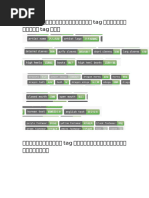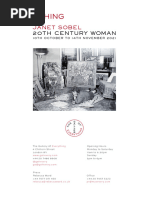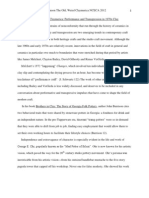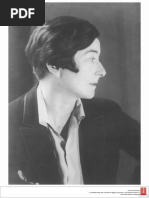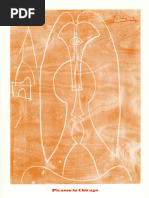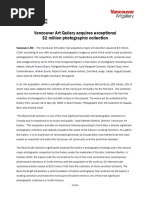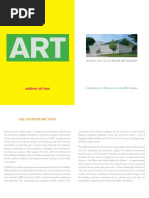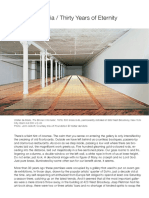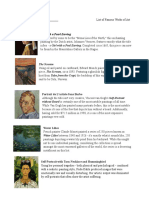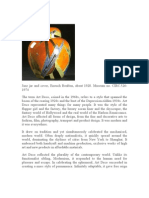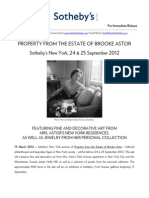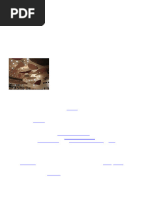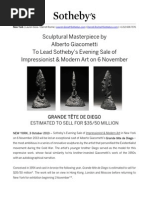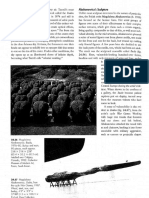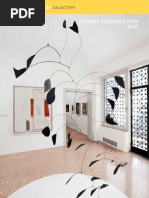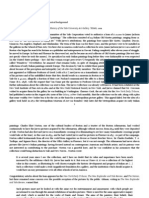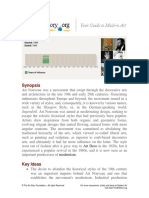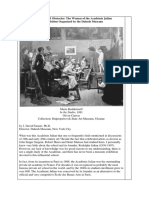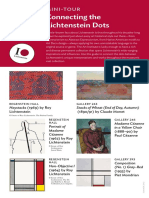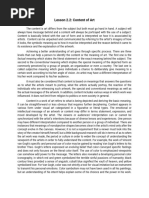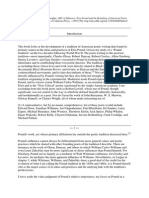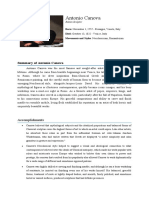My Kind of Town
My Kind of Town
Uploaded by
Alec NiculescuCopyright:
Available Formats
My Kind of Town
My Kind of Town
Uploaded by
Alec NiculescuOriginal Description:
Copyright
Available Formats
Share this document
Did you find this document useful?
Is this content inappropriate?
Copyright:
Available Formats
My Kind of Town
My Kind of Town
Uploaded by
Alec NiculescuCopyright:
Available Formats
m in i-tour
My Kind of Town
Whether you know it as the Windy City, the Second City,
or the City of Big Shoulders, youre sure to enjoy the rich
Chicago connections on this hometown tour of the museum.
Gallery 144
America Windows (1977) by Marc Chagall
The story of this visitor favorite began in the early 1970s
when French artist Marc Chagall came to Chicago for
work related to his mosaic, The Four Seasons, installed
outside Chase Tower. In response to the citys enthusiasm
for his work and the Art Institutes great support, the
artist offered to create a set of stained-glass windows for
the museum. After three years of planning, Chagall determined that the windows would
commemorate Americas bicentennial, celebrating the country as a place of cultural and religious freedom and detailing the arts of music, painting, literature, theater, and dance. Because
of his admiration for Chicago and its strong commitment to public art, Chagall chose to
dedicate the work to Mayor Richard J. Daley, a great supporter of public art projects.
Chicago Stock Exchange Trading Room
(18931894) by Dankmar Adler and Louis Sullivan
Reconstructed at the Art Institute in 1977 after its demolition in 19711972, the Chicago Stock Exchange Trading
Room was designed by Adler and Sullivan to be both
aesthetically pleasing and useful for commerce and trade.
Called the Father of the Skyscraper, Sullivan adorned
Chicagos skyline with buildings featuring opulent and
organic ornamentation. This room combines elements of styles ranging from the decorative borders of Celtic manuscripts to the luxuriance of Art Nouveau, with a particularly
complex use of stencilingthe elaborate, leaf-like designs use 57 different colors. Youll
also want to check out the Stock Exchanges original entrance arch, located in Brooks
McCormick Court on the east corner of the Modern Wing.
Gallery 262
Sky above Clouds IV (1965) by Georgia OKeeffe
While renowned for her images of the American Southwest,
Georgia OKeeffe had many ties to our fair city, particularly to the Art Institute. She studied at the School of the
Art Institute from 1905 to 1906, and in 1943 the museum
presented her first major retrospective, purchasing the
painting Black Cross at the close of the show. OKeeffe
reciprocated with several gifts of her work, and after the death of her husband, the photographer and art dealer Alfred Stieglitz, she gave the museum his extraordinary collection,
which added over 400 objects to the museums 20th-century American holdings. This work,
another gift from the artist, is the ultimate painting in a series in which OKeeffe captured her
in-flight experiences traveling all over the world. Ironically, the massive size of the work has
prevented it from doing much traveling itself, keeping it right here for us to enjoy in Chicago.
Gallery 240
A Sunday on La Grande Jatte1884 (188486)
by Georges Seurat
Georges Seurats world-famous masterpiece A Sunday
on La Grande Jatte1884 is perhaps the most beloved
work in the Art Institute. With its color theory, mesmerizing pointillist technique developed by Seurat himself,
and enigmatic characters and relationships, this image
of fashionable Parisians enjoying a day of leisure has long fascinated scholars and visitors
alike. The work received even further attention when the high schoolers of Ferris Buellers
Day Off made a stop at the Art Institute during their day of hooky-playing adventures in
Chicago. Ferriss friend Cameron becomes hypnotized by the little girl in white at the center
of the work, seeing her clearly from afar but having her dissolve into dots the closer he
looks. (Travel back to 1986 with the movies museum scene on YouTube, and zoom into the
last dot of this renowned masterpiece on the Google Art Project.)
Gallery 211
The Assumption of the Virgin (157779)
by Domenikos Theotokopoulos, called El Greco
Hard to believe, but when the Art Institute acquired this work in
1906, no one else was vying for it. The gigantic painting was the
centerpiece of El Grecos first major commission in Spain, but
the Crete-born artist had become rather obscure in the decades
following his initial success. When the painting reemerged in
Paris in 1904, however, avant-garde artists, including a young
Picasso and American Impressionist Mary Cassatt, became
quite enthusiastic about it. Cassatt, in fact, petitioned various
American museums to purchase the work, and after 19 months of deliberation, the Art
Institute agreed. In time, the work regained its original lauded status, all the while continuing to win notable admirers. Ernest Hemingway, who visited the museum often as a boy,
recalled The Assumption inspiring him to write as boldly as El Greco painted.
Gallery 200
Architectural Fragments
Home to the first skyscraper and the White City of the 1893
Worlds Columbian Exposition, Chicago has been the center of
American architecture since the late 19th century. The skyline
still teems with buildings designed by such legends as Dankmar
Adler, Daniel Burnham, and Louis Sullivan, but this gallery at
the top of the Grand Staircase houses treasures from these architects great buildings that are no longer standing. The graceful
fragments include Burnhams intricate ironwork, Sullivans iconic organic ornamentation,
and Frank Lloyd Wrights geometric, nature-inspired stained glass windows. Chicagos
storied past comes alive!
Looking for more fun and fast ways to connect with the Art Institute?
Like us on Facebook, follow us on Twitter, and take a real insiders look at the
museum with our blog, ARTicle. Plus, make sure youre signed up for our e-mails
to hear the latest news on all our upcoming exhibitions and events!
You might also like
- Nai3常规个人法典(含服装,场景等,… 10 1版,一般所长整理)Document238 pagesNai3常规个人法典(含服装,场景等,… 10 1版,一般所长整理)xh1479875376No ratings yet
- The Gallery of Everything Janet Sobel 20th Century Woman Press ReleaseDocument6 pagesThe Gallery of Everything Janet Sobel 20th Century Woman Press Releasejulio cesarNo ratings yet
- The Old Weird ClaymericaDocument12 pagesThe Old Weird ClaymericaGarth JohnsonNo ratings yet
- Picasso Forty Years of His Art MoMA 1939Document218 pagesPicasso Forty Years of His Art MoMA 1939Auriane StremelNo ratings yet
- Destino SDocument12 pagesDestino SMehmood AhmedNo ratings yet
- Unit 3-Neoclasssicism and Romanticism in The PhilippinesDocument35 pagesUnit 3-Neoclasssicism and Romanticism in The PhilippinesGina0% (1)
- How Wang-Fo Was Saved PresentationDocument9 pagesHow Wang-Fo Was Saved PresentationFeliciaMejNo ratings yet
- The Art Institute of Chicago (Art Ebook)Document292 pagesThe Art Institute of Chicago (Art Ebook)intuitionNo ratings yet
- L'Art de Vivre - The Designs of Eileen GrayDocument8 pagesL'Art de Vivre - The Designs of Eileen GrayPedroCaiadoNo ratings yet
- American Contemporary Art (December 2011)Document46 pagesAmerican Contemporary Art (December 2011)American Contempoary Art Magazine100% (1)
- StoriesfromtheMuseumofModernArtofNewYork SUNYAlbanyDocument30 pagesStoriesfromtheMuseumofModernArtofNewYork SUNYAlbanyPutri SalsabillahNo ratings yet
- An Edward Hopper Retrospective: The Museum of Fine Arts, Boston, And: Edward Hopper (Review)Document7 pagesAn Edward Hopper Retrospective: The Museum of Fine Arts, Boston, And: Edward Hopper (Review)Marius StanNo ratings yet
- Picasso en Chicago - Art Institute of ChicagoDocument124 pagesPicasso en Chicago - Art Institute of ChicagoAldo JohnsonNo ratings yet
- Chicago: Art Around The CityDocument2 pagesChicago: Art Around The CityDanielle KnowlesNo ratings yet
- Vancouver Art Gallery Acquires Exceptional $2 Million Photographic CollectionDocument3 pagesVancouver Art Gallery Acquires Exceptional $2 Million Photographic CollectionNéstor Delgado MoralesNo ratings yet
- Decorative Arts and Design CollectionDocument6 pagesDecorative Arts and Design Collectionlinguist_foreverNo ratings yet
- What Is Art DecoDocument3 pagesWhat Is Art DecoNurLatifah Chairil AnwarNo ratings yet
- OutdoorartDocument34 pagesOutdoorartapi-308557303No ratings yet
- 4 Museum of Contemporary Art (MCA) Chicago: It Brings Culture and Art TogetherDocument1 page4 Museum of Contemporary Art (MCA) Chicago: It Brings Culture and Art TogetherYel LowNo ratings yet
- Art & Culture in The United StatesDocument7 pagesArt & Culture in The United StatesEdward LeoNo ratings yet
- 02 - Intervencija Crtezom U Interijeru - Walter de MariaDocument5 pages02 - Intervencija Crtezom U Interijeru - Walter de MariaKristijan VrdoljakNo ratings yet
- Henri Bouyett Cultural Event Topic Museum of Science and IndustryDocument6 pagesHenri Bouyett Cultural Event Topic Museum of Science and Industrymadskater1990mNo ratings yet
- List of Famous PaintingsDocument3 pagesList of Famous Paintingsapi-340853699No ratings yet
- CatalogDocument50 pagesCatalogbatotaNo ratings yet
- National Gallery, Washington-Newsweek (1968)Document174 pagesNational Gallery, Washington-Newsweek (1968)Gary Tan100% (2)
- Press Release of MoMA ExhibitionDocument4 pagesPress Release of MoMA ExhibitionZsófia AlbrechtNo ratings yet
- Gustave Caillebotte: The Painter's Eye' ReviewDocument4 pagesGustave Caillebotte: The Painter's Eye' ReviewBoudaoud FamilyNo ratings yet
- Alexander Calder R SoloDocument108 pagesAlexander Calder R Solorataburguer100% (3)
- Art DecoDocument54 pagesArt DecoLiv Maria100% (1)
- Antiquities To Impressionism PDFDocument140 pagesAntiquities To Impressionism PDFNané Wapash100% (1)
- Jeff Koons Was Born On January 21Document3 pagesJeff Koons Was Born On January 21Jae Yong LeeNo ratings yet
- Illusion in Painting 1964Document33 pagesIllusion in Painting 1964Ljubica Velkova100% (5)
- Egon SchieleDocument146 pagesEgon SchieleMicaela Costilla100% (10)
- The Broad, Los Angeles's Snazzy New Museum - The New YorkerDocument4 pagesThe Broad, Los Angeles's Snazzy New Museum - The New YorkerSouthwestern College Visual Resource CenterNo ratings yet
- Property From The Estate of Brooke Astor - Legendary Society Figure - at Sotheby's New YorkDocument4 pagesProperty From The Estate of Brooke Astor - Legendary Society Figure - at Sotheby's New YorkGavel100% (1)
- Christie's New York - First Open Post-War and Contemporary Art - September 26, 2013Document5 pagesChristie's New York - First Open Post-War and Contemporary Art - September 26, 2013GavelNo ratings yet
- Anne Vallayer-Coaster - Painter To The Court of Marie-AntoinetteDocument7 pagesAnne Vallayer-Coaster - Painter To The Court of Marie-Antoinettedanielson3336888No ratings yet
- Claes Oldenburg: Soft Bathtub (Model) - Ghost Version by Claes OldenburgDocument2 pagesClaes Oldenburg: Soft Bathtub (Model) - Ghost Version by Claes OldenburgjovanaspikNo ratings yet
- The Museum of Iviodem Art ZLZFLFMT'': Tight BindingDocument5 pagesThe Museum of Iviodem Art ZLZFLFMT'': Tight BindingValeriaTellezNiemeyerNo ratings yet
- Alexander CalderDocument3 pagesAlexander CalderTomas CechiNo ratings yet
- Art Appreciation. Art Museum, Recreation, Pop Art, Op ArtDocument10 pagesArt Appreciation. Art Museum, Recreation, Pop Art, Op ArtMERBUEN BACUSNo ratings yet
- Sotheby's Announces Two Major Highlights of Its Impressionist & Modern Art Evening Sale in New York - 6 November 2013Document6 pagesSotheby's Announces Two Major Highlights of Its Impressionist & Modern Art Evening Sale in New York - 6 November 2013GavelNo ratings yet
- Dutch and Flemish Paintings From The HermitageDocument158 pagesDutch and Flemish Paintings From The HermitageJaneth Rodríguez Nóbrega100% (14)
- HH Arnason - The Pluralistic 70's (Ch. 24b)Document36 pagesHH Arnason - The Pluralistic 70's (Ch. 24b)KraftfeldNo ratings yet
- Art Masterpieces of The National Gallery London (Art Ebook)Document72 pagesArt Masterpieces of The National Gallery London (Art Ebook)louloudos1No ratings yet
- Decorative Arts of The Twentieth Century The Metropolitan Museum of Art Bulletin V 37 No 3 Winter 1979 1980Document56 pagesDecorative Arts of The Twentieth Century The Metropolitan Museum of Art Bulletin V 37 No 3 Winter 1979 1980Pavel Kiryukhin100% (1)
- Interns Guide 2010 MailDocument19 pagesInterns Guide 2010 MailpatorrusoNo ratings yet
- Margherita Viggiano Yale HandoutDocument22 pagesMargherita Viggiano Yale HandoutIvyGateNo ratings yet
- In Search of a Lost Avant-Garde: An Anthropologist Investigates the Contemporary Art MuseumFrom EverandIn Search of a Lost Avant-Garde: An Anthropologist Investigates the Contemporary Art MuseumNo ratings yet
- Egyptian Colloquial - AnistuunaDocument12 pagesEgyptian Colloquial - AnistuunaCarlos Alberto de MendonçaNo ratings yet
- VALDEZ, Jhoanne F. GED108 Activity2Document12 pagesVALDEZ, Jhoanne F. GED108 Activity2Jhoanne ValdezNo ratings yet
- Moma Catalogue 2798 300061975Document89 pagesMoma Catalogue 2798 300061975gxyartNo ratings yet
- Wax SculptureDocument3 pagesWax SculptureJustine Eryza Delos ReyesNo ratings yet
- Artbook D.A.P.: Spring/Summer 2013 Title SupplementDocument13 pagesArtbook D.A.P.: Spring/Summer 2013 Title SupplementalejandroNo ratings yet
- Art of The People Pierre Alechinsky andDocument10 pagesArt of The People Pierre Alechinsky andpoubellepourpubfortNo ratings yet
- Survey Article On The Turner Prize ShortlistDocument2 pagesSurvey Article On The Turner Prize ShortlistPádraig BeltonNo ratings yet
- Academia JulianDocument7 pagesAcademia JulianMoniq MaresNo ratings yet
- The Portland Vase: Mania & Muse (1780-2023)From EverandThe Portland Vase: Mania & Muse (1780-2023)Mariah Carmen BrielNo ratings yet
- Washington D.C. SW 2594Document14 pagesWashington D.C. SW 2594Francisca MoreiraNo ratings yet
- The Burlington Magazine Publications LTDDocument3 pagesThe Burlington Magazine Publications LTDAna Žigo100% (1)
- Kimbell Museum Appoints Shackelford As Senior Deputy DirectorDocument3 pagesKimbell Museum Appoints Shackelford As Senior Deputy DirectorLee Rosenbaum, CultureGrrlNo ratings yet
- Unhinging of Site SpecificityDocument12 pagesUnhinging of Site SpecificityJody TurnerNo ratings yet
- Judaism For Gentiles CompleteDocument406 pagesJudaism For Gentiles CompleteAlec NiculescuNo ratings yet
- Hup History2017Document37 pagesHup History2017Alec NiculescuNo ratings yet
- Connecting The Lichtenstein DotsDocument2 pagesConnecting The Lichtenstein DotsAlec NiculescuNo ratings yet
- Welcome To The Harvard University Press Religion Brochure: ... and Keep in TouchDocument13 pagesWelcome To The Harvard University Press Religion Brochure: ... and Keep in TouchAlec NiculescuNo ratings yet
- Fifth Balkan Symposium of Archaeometry 2016: Bridging Science and HeritageDocument3 pagesFifth Balkan Symposium of Archaeometry 2016: Bridging Science and HeritageAlec NiculescuNo ratings yet
- VanderHeydenPR ImagesheetDocument6 pagesVanderHeydenPR ImagesheetAlec NiculescuNo ratings yet
- Varia 3Document2 pagesVaria 3Alec NiculescuNo ratings yet
- Mikhail Klodt (1832-1902) - A Riverside Farm - Russian Pictures Auction - Li - PDFDocument3 pagesMikhail Klodt (1832-1902) - A Riverside Farm - Russian Pictures Auction - Li - PDFAlec NiculescuNo ratings yet
- Excel ProduceDocument29 pagesExcel ProduceAb Aziz IkhwanNo ratings yet
- Haptic Experience in The Writings of Georges Bataille, Maurice Blanchot and Michel SerresDocument328 pagesHaptic Experience in The Writings of Georges Bataille, Maurice Blanchot and Michel SerrespnzkbtkpdxNo ratings yet
- Lesson 2.2 Content of ArtDocument3 pagesLesson 2.2 Content of ArtPerly CielyNo ratings yet
- Asa, Marck Anthony DJ. Bs-It 3B Assessment 2 - Module 2Document7 pagesAsa, Marck Anthony DJ. Bs-It 3B Assessment 2 - Module 2Hershey GalvezNo ratings yet
- Architectural Styles and MovementsDocument2 pagesArchitectural Styles and MovementsYessaMartinez100% (1)
- Adobe Photoshop & HistoryDocument14 pagesAdobe Photoshop & HistoryJaniceCasasJecielNo ratings yet
- Ashar Merac E-BrochureDocument23 pagesAshar Merac E-Brochureconnect.adtecmediaNo ratings yet
- Art Appreciation Lesson 4 PDFDocument7 pagesArt Appreciation Lesson 4 PDFczeremar chanNo ratings yet
- Art Appreciation GEC 006Document4 pagesArt Appreciation GEC 006IanaCarandangNo ratings yet
- Traditional Indian TexDocument48 pagesTraditional Indian TexShantav GargNo ratings yet
- Artistic Development in Fashion Design: Clemens ThornquistDocument160 pagesArtistic Development in Fashion Design: Clemens ThornquistDurga BudhathokiNo ratings yet
- Art Grade 10 Week 2Document21 pagesArt Grade 10 Week 2Martin Rodriguez100% (2)
- Isosceles Triangle, Golden Ratio, Great Pyramid at Giza & Penrose TilingDocument26 pagesIsosceles Triangle, Golden Ratio, Great Pyramid at Giza & Penrose TilingDr Srinivasan Nenmeli -KNo ratings yet
- ABC of Influence - Ezra PoundDocument170 pagesABC of Influence - Ezra Poundemasumiyat100% (1)
- Basic Principles and Elements of Landscape DesignDocument13 pagesBasic Principles and Elements of Landscape DesignAnaz AnazNo ratings yet
- LEONARDO DA VInciDocument17 pagesLEONARDO DA VInciyohprNo ratings yet
- Jorgeluis La Industria de La Cascarilla Junio 2008 BlogDocument2 pagesJorgeluis La Industria de La Cascarilla Junio 2008 BlogPablo OrtegaNo ratings yet
- Joey GabrielDocument5 pagesJoey GabrielAndré PitolNo ratings yet
- The Role of Memory Image Place and StorDocument18 pagesThe Role of Memory Image Place and StorAmanda MocoNo ratings yet
- Dota AllstarsDocument2 pagesDota AllstarsJosanie JavellanaNo ratings yet
- Cameleon Christ Shepherd Lamb Cross CrucifixDocument11 pagesCameleon Christ Shepherd Lamb Cross CrucifixВиктор Бушиноски МакедонскиNo ratings yet
- Summary of Antonio CanovaDocument8 pagesSummary of Antonio CanovaZarahJoyceSegoviaNo ratings yet
- Method StatementDocument63 pagesMethod StatementMikku Katta75% (4)
- Asian Paints1Document25 pagesAsian Paints1Hardik PrajapatiNo ratings yet
- Module in Drafting TLE 6Document24 pagesModule in Drafting TLE 6JillaRina Ortega CoNo ratings yet
- Reading Part 2 PETDocument82 pagesReading Part 2 PETChi HoàngNo ratings yet
